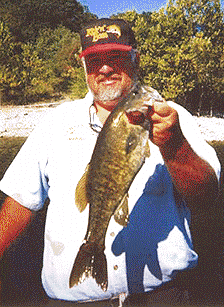

Member of the Kick'n BassŪ Pro-Staff
Rick's Chauffeured Guide Service
Table Rock Lake
No part of this article may be reproduced without permission of Rick La
Point
www.strikebass.com
Fishing that darned Fluke
Spring is here. The familiar sounds of birds singing their early morning songs fill the
air. The warm mornings smell fresh while cruising down the lake at an easy pace. Soaking
up the morning sun, as you pull up on a gravel bank. As you are rigging this fish-like
piece of plastic on a large sharp hook, you notice a cleared out area of gravel. The males
are starting to nest. You back off a little deeper, suspecting an unwary female cruising
the area for suitable males nesting site. Tossing out that fishy thing you let it sink
slowly to the bottom. Suddenly the line tightens you lean forward giving the bass a second
or two to swim away, and Wham! A long sweeping hook set strikes solid. The unsuspecting
bass pulls hard stripping your drag on your reel. You bow to the pressure knowing your
line is only 10 # test. The bass surges down deep with several hard runs; you feel the
throbbing headshake indicating a larger fish. Slowly the line rises to the surface and she
breaks the surface. Man, what a beauty! You gingerly ease her to the boat, reaching down
grasping her lower jaw with your whole hand. Gently unhooking her you lower her into the
water and watch her slowly swim away.

Ryan Jaskiewcz with a couple huge fluke bass, caught with Guide, Rick La Point. Fluke
fishing, a great technique to catch pre-spawn and post-spawn bass. The bass can't stand
the slow sinking action of the Fluke. The tail twitches as it sinks giving it a unique
action. The back and forth twitches as you retrieve act like a dying shad trying to escape
it's most feared enemy. Proper rigging of the Fluke is most crucial to its success. (See
fig.1 and fig. 2 for basic rigging)

Making sure that the lure is hanging straight and doesn't spin when you
retrieve it is very significant. Otherwise when you retrieve it, your line will twist and
then, well, you know what happens. I rig my Fluke with a 4/0 or 5/0 Gamagatsu hook. This
hook has a wide gap, which is necessary so you can jerk the hook through the body of the
Fluke. This hook has increased my client hook ups by 25%. There are several types of
retrieving methods I use with the Fluke. The water temperature and the stage of the bass
in relation to the spawn are the factors. In the pre-spawn stage I tend to fish it like a
jig or worm. Slow twitches with long pauses in between. In the post-spawn stage I fish it
a little faster, sometimes even twitching it across the surface.
The rod and reel that I use for Fluke fishing is a Jim Grandt Custom XLH70 Rod 6'6'' med.
Action casting rod. The sensitivity of this rod outperforms any rods I have fished. Paired
with a smooth Shimano Coriolis this fishing instrument is the ultimate Fluke fishing tool.
The hook set is probably the big reason most anglers lose sometimes as much as 50%
of the bass that bite this lure. The proper technique to use is when you feel a little
weight or a bite, lean forward as far as you can, reeling in your slack until you feel the
tension then give it a hard long sweeping hook set. Using this technique will increase
your hook up percentages. In clear water where you can see some of the strikes it is
imperative that you wait a few seconds before you set the hook. Let the fish turn away
from you then set the hook. Otherwise you will jerk the lure right out of the fishes
mouth. Weights can be added to your Fluke to allow it to sink a little faster or help hold
it down on a windy day. The method I use is a lead nail inserted in the body. This lets
the Fluke fall naturally like a dying shad. Another method to weight your Fluke is to tie
a black barrel swivel 18 inches above the lure. It gives it just enough weight to help you
on a windy day. These fat little minnow shaped lures sure got some action and are
definitely a lure you need in your tackle box.
To return to articles page click here.
To return to Home Page click here.